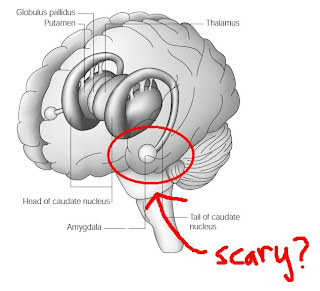Passionate, sincere, and selfless Dr. Warren Chapin has spent his life trying to understand one of the oldest, most prominent, and most mysterious of human emotions: Fear. Working from his lab, meticulously experimenting on various mammals, perpetually failing to identify the source of this bizarre and ubiquitous phenomenon, Dr. Chapin all but gives up his pursuit. Then one day he discovers that violent screaming is instrumental in releasing a person's 'fear tensions', and concludes that the answer to his question lies in a simple experiment: What happens when a person cannot scream? The answer? Well, potentially, death. More precisely, the parasitic slug/centipede-like organism (i.e., the ‘tingler’) that lives undetected at the base of the human spine grows when its host is aroused. This organism is paralyzed by the frightened screams of the person it inhabits. If a person is unable to scream, the tingler grows out of control and terror ensues. That is obvious.
The Tingler (Castle, 1959) is a fantastic piece of science fiction/horror, using a fancifully imaginative basis for its plot. The film is adorable, and Vincent Price gives a delightful performance as our charming and mistrustful protagonist. For our purposes, however, The Tingler also stands as a testament to the inaccessibility of brain science mid-century, and helps expose (in a somewhat exaggerated manner) the advancements of modern neuropsychology. We now know that the processing of fear in the human brain relies heavily (though by no means exclusively) on the workings of a small almond-shaped nucleus called the amygdala; patients with damage to this brain structure show deficits in both interpreting and experiencing fear (see Calder, Lawrence & Young, 2001). But even in light of our current knowledge about the brain, the idea of a vicious, mindless, spine-dwelling parasite remains charming, and is certainly more in line with the phenomenology of fear and our intuitions about it. After all, we do feel tingles when we are highly aroused, and slimy, squiggly parasites are much more frightening than almonds.
Check out The Tingler at:
References
Calder, AJ., Lawrence, AD., & Young, AW. (2001). The neuropsychology of fear and loathing. Nature, 2, 353-363.
Castle, W. (Producers), Castle, W.. (Director). (1959). The Tingler [Motion picture]. USA: Columbia Pictures.




No comments:
Post a Comment